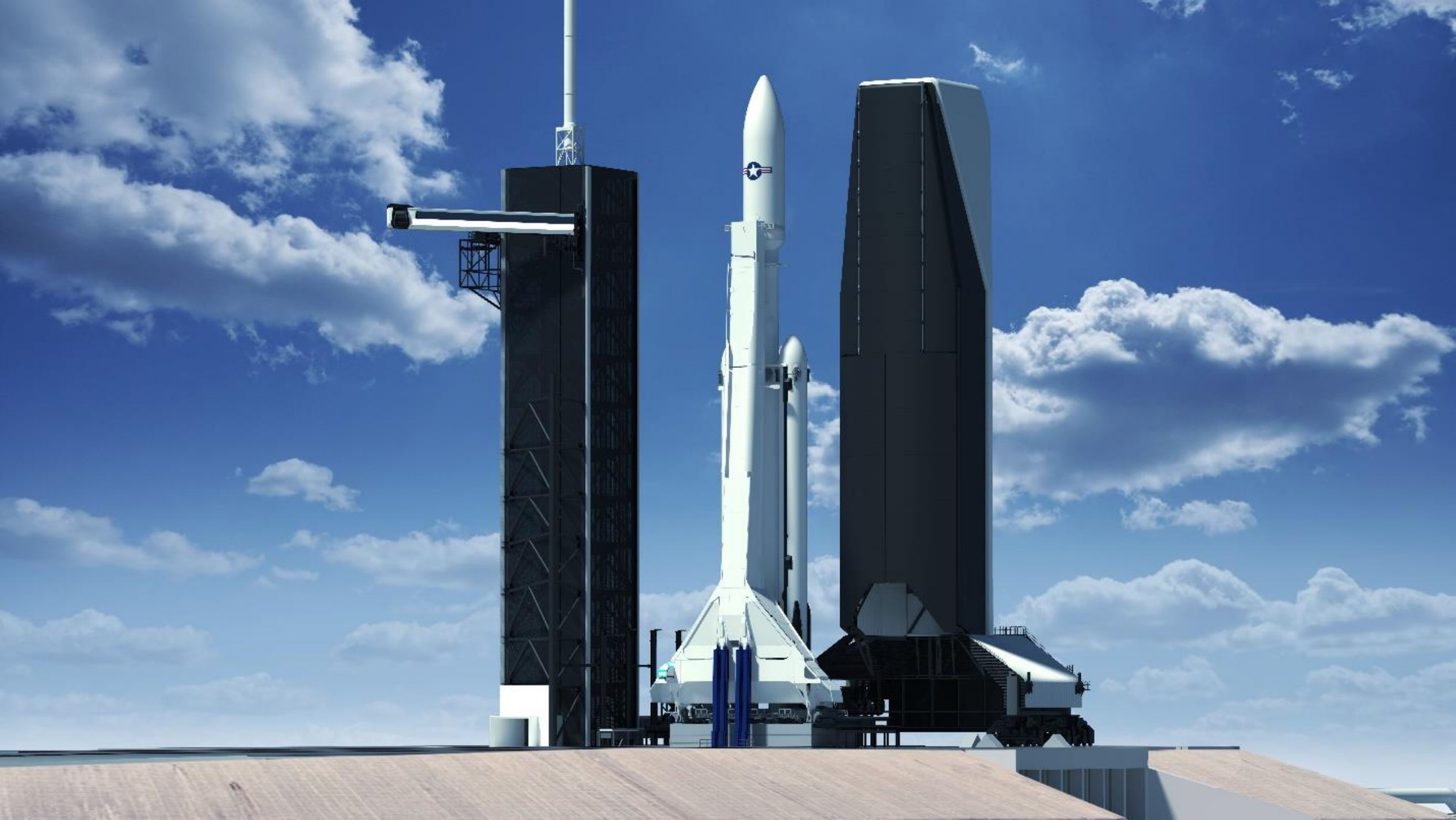
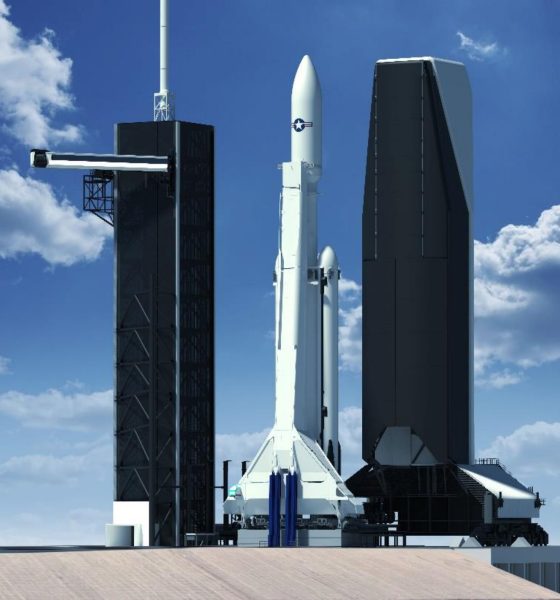
News
SpaceX envisions massive rocket enclosure for military applications
SpaceX has published the first renders of a massive tower (MST) designed to fully enclose a Falcon Heavy rocket, giving the US military access to certain prized satellite payloads even when the vehicle is vertical at the launch pad.
Stretching some 70 m (230 ft) tall and 12.2 m (40 ft) wide, building a movable tower capable of fully enclosing SpaceX’s Falcon Heavy rockets is no mean feat. Known as a mobile service tower (MST), SpaceX has managed to avoid the need for the expensive, complex, and extremely unwieldy infrastructure for the first decade of Falcon 9 and Falcon Heavy launch operations. Instead, SpaceX has designed its launch vehicles around the concept of horizontal integration, meaning that its Falcon rockets can be entirely integrated and prepared for flight before going vertical for launch. This approach has ensured easy, cheap access to the entire rocket and payload up until the last few days of static fire and launch operations, lowering the cost of launch.
Beyond Russian spaceflight operations, SpaceX, and a handful of other companies around the world, nearly all other major launch providers and space agencies – including the United Launch Alliance (ULA), Arianespace, ISRO (India), and CNSA (China) – rely almost exclusively on vertical integration. With its new Pad 39A mobile tower, SpaceX will soon join that small club, giving it the ability to compete on completely even footing with ULA and others for lucrative military launch contracts.
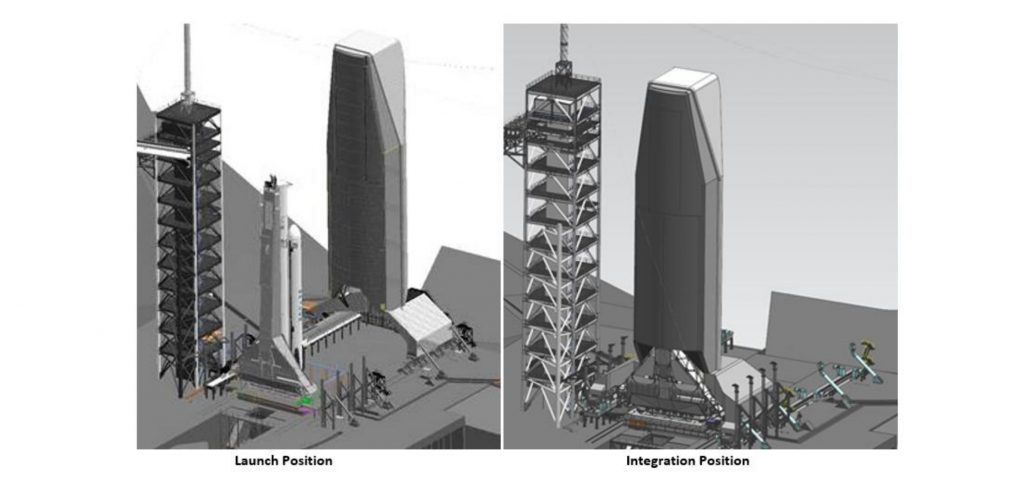
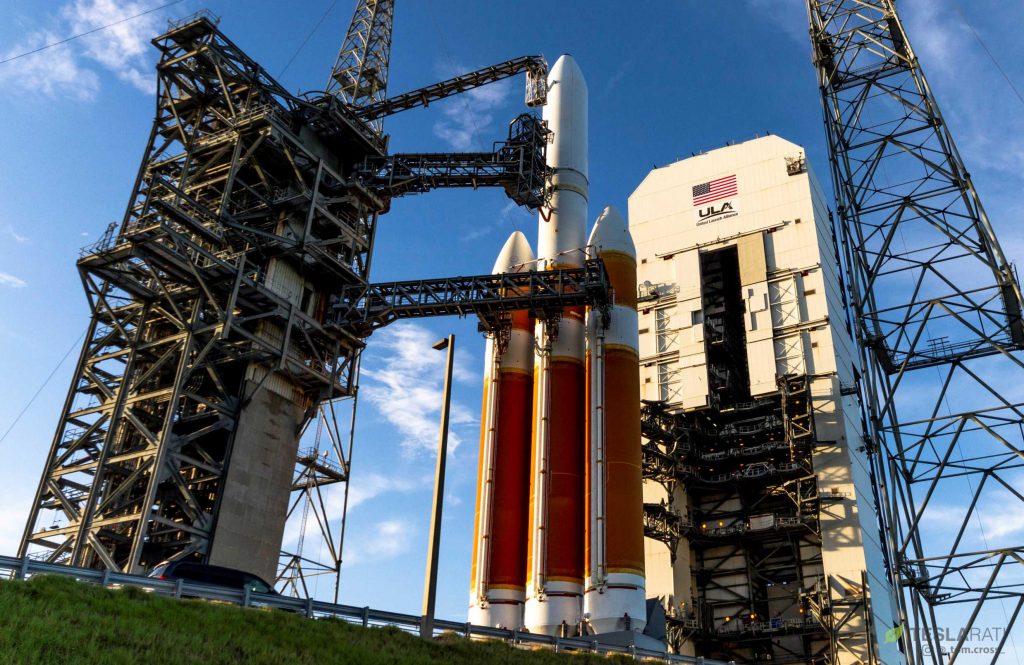
While one only has so much flexibility when designing a mobile skyscraper that needs to survive Florida’s hurricane seasons, SpaceX’s solution is still visually unique. According to the company, the mobile service tower (MST) it plans to build at its Kennedy Space Center (KSC) Launch Complex 39A (Pad 39A) facilities will measure 87m (284 ft) from its wheels to the top of its roof, while the tower’s ‘crawler’ base will be some 36m x 33m (118 ft x 108 ft) wide, a quarter of the area of a US football field.
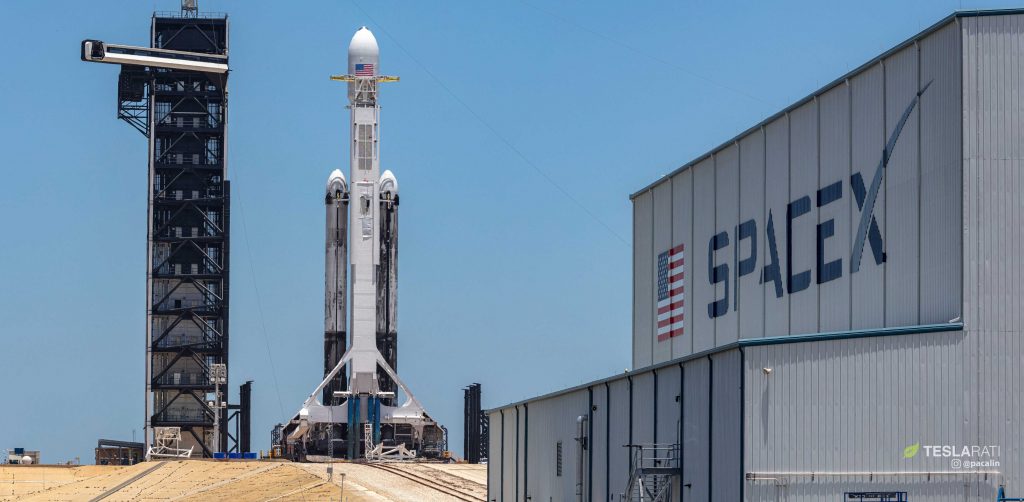
During launch preparations, SpaceX would integrate its Falcon Heavy and Falcon 9 rockets like usual, joining boosters, side boosters, upper stages, and recovery while still horizontal inside its Pad 39A hangar. The integrated rocket would be installed (still horizontal) on 39A’s transporter/erector (T/E) – the white steel structure seen backing the rocket above – and rolled out to the launch mount, where the T/E is effectively bolted into the ground before lifting the rocket vertical.
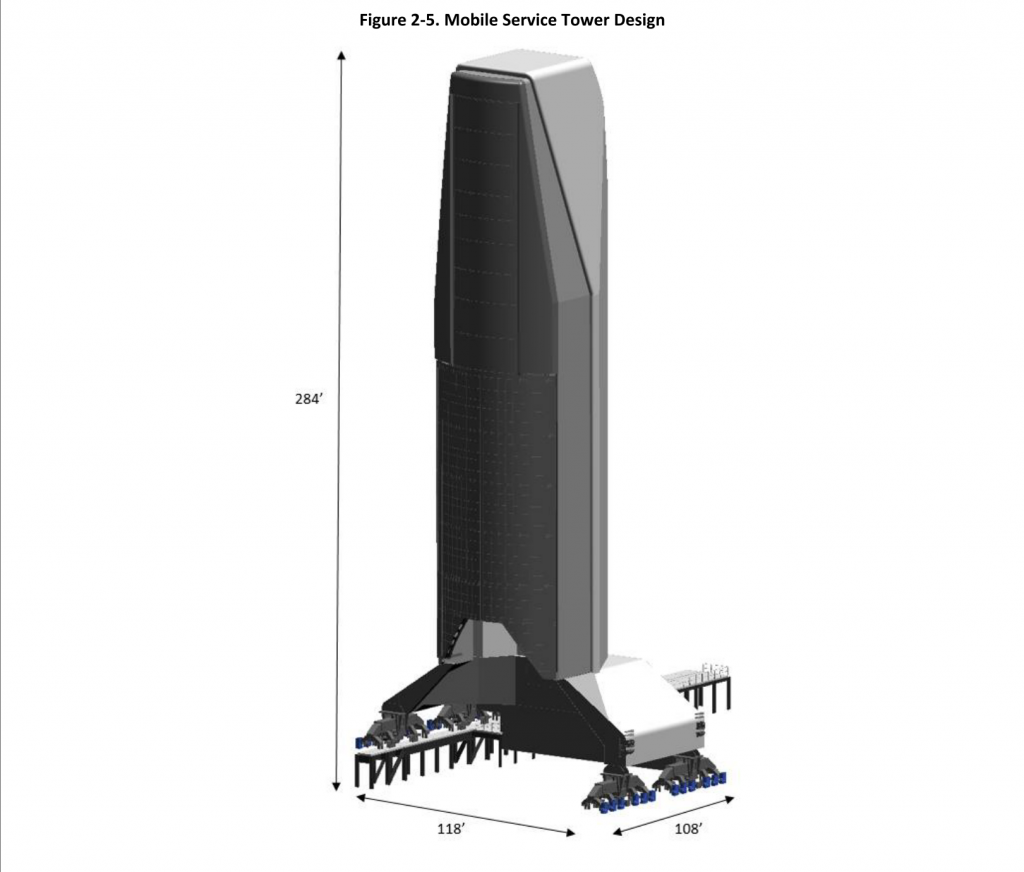
Once vertical, SpaceX’s new tower would slowly crawl about 40m (130 ft) to fully encompass a given Falcon Heavy or Falcon 9 rocket. Once safely inside the MST, 11 different levels would give SpaceX and customer technicians access to the vast majority of the rocket. Most importantly, the tower would allow SpaceX technicians to crane certain US military payloads – encapsulated inside a Falcon payload fairing – onto the top of the rocket.
At the end of the day, that’s really the only reason SpaceX needs such a tower – certain customers (the US military and, to a lesser extent, NASA) have certain payloads that they either can’t or won’t tweak to allow for horizontal integration. No schedule for the MST construction has been mentioned yet but knowing SpaceX, it’s safe to say it could be completed sooner than later once environmental impact studies are complete and construction permits have been secured.
Check out Teslarati’s Marketplace! We offer Tesla accessories, including for the Tesla Cybertruck and Tesla Model 3.

News
Tesla FSD fleet is nearing 7 billion total miles, including 2.5 billion city miles
As can be seen on Tesla’s official FSD webpage, vehicles equipped with the system have now navigated over 6.99 billion miles.

Tesla’s Full Self-Driving (Supervised) fleet is closing in on almost 7 billion total miles driven, as per data posted by the company on its official FSD webpage.
These figures hint at the massive scale of data fueling Tesla’s rapid FSD improvements, which have been quite notable as of late.
FSD mileage milestones
As can be seen on Tesla’s official FSD webpage, vehicles equipped with the system have now navigated over 6.99 billion miles. Tesla owner and avid FSD tester Whole Mars Catalog also shared a screenshot indicating that from the nearly 7 billion miles traveled by the FSD fleet, more than 2.5 billion miles were driven inside cities.
City miles are particularly valuable for complex urban scenarios like unprotected turns, pedestrian interactions, and traffic lights. This is also the difference-maker for FSD, as only complex solutions, such as Waymo’s self-driving taxis, operate similarly on inner-city streets. And even then, incidents such as the San Francisco blackouts have proven challenging for sensor-rich vehicles like Waymos.
Tesla’s data edge
Tesla has a number of advantages in the autonomous vehicle sector, one of which is the size of its fleet and the number of vehicles training FSD on real-world roads. Tesla’s nearly 7 billion FSD miles then allow the company to roll out updates that make its vehicles behave like they are being driven by experienced drivers, even if they are operating on their own.
So notable are Tesla’s improvements to FSD that NVIDIA Director of Robotics Jim Fan, after experiencing FSD v14, noted that the system is the first AI that passes what he described as a “Physical Turing Test.”
“Despite knowing exactly how robot learning works, I still find it magical watching the steering wheel turn by itself. First it feels surreal, next it becomes routine. Then, like the smartphone, taking it away actively hurts. This is how humanity gets rewired and glued to god-like technologies,” Fan wrote in a post on X.
News
Tesla starts showing how FSD will change lives in Europe
Local officials tested the system on narrow country roads and were impressed by FSD’s smooth, human-like driving, with some calling the service a game-changer for everyday life in areas that are far from urban centers.

Tesla has launched Europe’s first public shuttle service using Full Self-Driving (Supervised) in the rural Eifelkreis Bitburg-Prüm region of Germany, demonstrating how the technology can restore independence and mobility for people who struggle with limited transport options.
Local officials tested the system on narrow country roads and were impressed by FSD’s smooth, human-like driving, with some calling the service a game-changer for everyday life in areas that are far from urban centers.
Officials see real impact on rural residents
Arzfeld Mayor Johannes Kuhl and District Administrator Andreas Kruppert personally tested the Tesla shuttle service. This allowed them to see just how well FSD navigated winding lanes and rural roads confidently. Kruppert said, “Autonomous driving sounds like science fiction to many, but we simply see here that it works totally well in rural regions too.” Kuhl, for his part, also noted that FSD “feels like a very experienced driver.”
The pilot complements the area’s “Citizen Bus” program, which provides on-demand rides for elderly residents who can no longer drive themselves. Tesla Europe shared a video of a demonstration of the service, highlighting how FSD gives people their freedom back, even in places where public transport is not as prevalent.
What the Ministry for Economic Affairs and Transport says
Rhineland-Palatinate’s Minister Daniela Schmitt supported the project, praising the collaboration that made this “first of its kind in Europe” possible. As per the ministry, the rural rollout for the service shows FSD’s potential beyond major cities, and it delivers tangible benefits like grocery runs, doctor visits, and social connections for isolated residents.
“Reliable and flexible mobility is especially vital in rural areas. With the launch of a shuttle service using self-driving vehicles (FSD supervised) by Tesla in the Eifelkreis Bitburg-Prüm, an innovative pilot project is now getting underway that complements local community bus services. It is the first project of its kind in Europe.
“The result is a real gain for rural mobility: greater accessibility, more flexibility and tangible benefits for everyday life. A strong signal for innovation, cooperation and future-oriented mobility beyond urban centers,” the ministry wrote in a LinkedIn post.
News
Tesla China quietly posts Robotaxi-related job listing
Tesla China is currently seeking a Low Voltage Electrical Engineer to work on circuit board design for the company’s autonomous vehicles.

Tesla has posted a new job listing in Shanghai explicitly tied to its Robotaxi program, fueling speculation that the company is preparing to launch its dedicated autonomous ride-hailing service in China.
As noted in the listing, Tesla China is currently seeking a Low Voltage Electrical Engineer to work on circuit board design for the company’s autonomous vehicles.
Robotaxi-specific role
The listing, which was shared on social media platform X by industry watcher @tslaming, suggested that Tesla China is looking to fill the role urgently. The job listing itself specifically mentions that the person hired for the role will be working on the Low Voltage Hardware team, which would design the circuit boards that would serve as the nervous system of the Robotaxi.
Key tasks for the role, as indicated in the job listing, include collaboration with PCB layout, firmware, mechanical, program management, and validation teams, among other responsibilities. The role is based in Shanghai.
China Robotaxi launch
China represents a massive potential market for robotaxis, with its dense urban centers and supportive policies in select cities. Tesla has limited permission to roll out FSD in the country, though despite this, its vehicles have been hailed as among the best in the market when it comes to autonomous features. So far, at least, it appears that China supports Tesla’s FSD and Robotaxi rollout.
This was hinted at in November, when Tesla brought the Cybercab to the 8th China International Import Expo (CIIE) in Shanghai, marking the first time that the autonomous two-seater was brought to the Asia-Pacific region. The vehicle, despite not having a release date in China, received a significant amount of interest among the event’s attendees.








